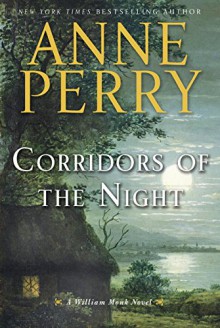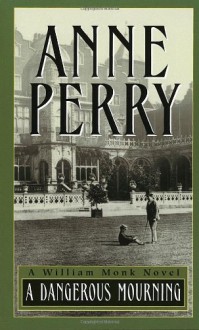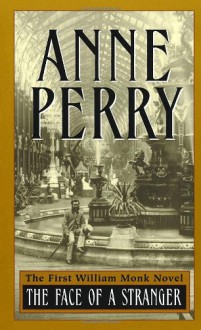

Note: While this is the 21st book in this series, it worked pretty well as a stand lone. My only comment is that several of the side characters are fully formed and it takes several hints to figure out what they do. I expect they were introduced far earlier in the series and the author expected the reader to already be acquainted with them.
Set in the latter half of the 1800s not too long after the Crimean War, nurse Hester Monk is working at London’s Royal Naval Hospital annex when she comes across three young siblings who are not doing so well. As she investigates, a case of questionable medical experimentation comes to light even as Hester does her best to save Bryson Radnor, an elderly man dying of the white blood disease. Hamilton Rand, a chemist, is dead set on discovering why blood transfusions from the three siblings work where most donated blood fails.
Hester Monk served as a nurse in the Crimean War and her husband, William Monk, is commander of the Thames River Police. Together, they make a formidable force. However, this is primarily Hester’s story. We do get one little interlude of police work on the river as William and his crew deal with some gun runners (though that section stood out as a little odd because it was completely unrelated to the plot). Hester’s wits, patience, knowledge, and compassion are on display in this tale.
Asked to stand in for an ill friend, Hester has a temporary nursing gig at the Naval annex working the night shift. During one of these nights, the young girl Maggie finds her and begs her to come have a look at her brother Charlie. When Hester lays eyes upon the young boy, she quickly sees that he is in need of medical care. She sits with them (and the youngest sibling Mike) throughout the night, providing water to Charlie. In the morning, she asks Dr. Magnus Rand about them and he says he will see to them.
Hester is then assigned to assist Dr. Rand’s brother, Hamilton Rand, a chemist, with his patient, Bryson Radnor, who is ill with the white blood disease (which might be the early term for chronic lymphocytic leukemia). Anyway, he’s a cranky old man who is being treated by a brusque, goal-oriented sexist. As you can see, Hester has her work cut out for her. Hester soon learns that Hamilton is taking blood from the three young siblings and transfusing it into Bryson, and it works. He wants to know why it works but first he has to keep his patient alive long enough to prove that this is a ‘cure’. I found all the medical stuff pretty interesting. I am sure the author had to do some detailed research on what was known at the time about blood transfusions and white blood disease. That research comes through in the writing as the characters never enter a time warp and use modern terms or have some unprecedented medical epiphany on blood types.
Of course, Hester objects. The kids have no parents or other relatives about approving the procedure and Charlie is obviously suffering from the blood letting. Hamilton feels he is left with no choice but to knock Hester unconscious and kidnap her away with his patient to some secluded country manor where treatment may continue. There, Hester has more time to get to know the kids, Bryson, and Bryson’s grown daughter Adrienne.
Meanwhile, William Monk is going a little nuts over his missing wife. He just got back from this gun runner business and it is very unlike Hester to not leave word as to where she is. At this point, the story pulls in several side characters that were most likely introduced earlier in the series. They assist in tracking Hester down, as well as finding the parents of the three kids. I got some of these side characters mixed up as not many descriptors were used with them (though I think if you have read previous books in this series, you wouldn’t have any trouble).
Then that whole bit is resolved and we still have about a third of the book to go. I was surprised at the quick wrap up to Hester’s abduction. The last third of the book is mostly courtroom drama, though there is some sleuthing both Hester and William undertake. I found this section of the book less entertaining than the first two-thirds. And, again, more side characters that are obviously old time favorites are drawn in, such as the lawyer Oliver Rathbone.
Overall, I found the book interesting and it was a look into Victorian England that I haven’t explored before. I quite enjoyed all the medical stuff. Hester’s character was fun too. She’s got a sharp tongue that sometimes gets away from her. After all, she spent quality time around military men who were in serious pain. Most of the side characters, while obviously on good terms with Hester and William, left me feeling like I was missing something. Admittedly, this is my first Anne Perry book. So, I think if folks have read previous books in this series, they probably wouldn’t have this feeling. I really liked that there was no cut and dry bad guy. Hamilton Rand had distinct reasons for doing as he did and while dismissive of the female gender in general, he didn’t outright mistreat women. Bryson Radnor wanted to live, and live a full life. Adrienne Radnor wanted her father healthy, probably so she could go on to live her own life instead of nursing him. This aspect of the story was well done and made the plot all the more interesting.
I won a copy of this book from the publisher via GoodReads.
Narration: David Collacci did a good job with this book. He had a variety of regional accents for the characters. His female voices were believable. He also did a great job with the voices for the little kids. I especially liked his voice for Bryson as it was a kind of gravelly old man’s voice, but an old man who could also be a little obscene or clever as the mood took him.


 Walkies!
Walkies! This is the mediocre murder mystery of Ms Moirdore (Mordor) - in her very own boudoir, at that! Enjoyable enough as I tramped through newly sprouted spring green birches. Perry writes in a slow style that couches repetitious information which seems baggy in today's crime fiction world.
This is the mediocre murder mystery of Ms Moirdore (Mordor) - in her very own boudoir, at that! Enjoyable enough as I tramped through newly sprouted spring green birches. Perry writes in a slow style that couches repetitious information which seems baggy in today's crime fiction world.
Set in London in the 1850s (no dates are given, but the Crimean War is prominent), The Face of a Stranger is the first in a 20-volume series of novels featuring detective William Monk. In an inventive twist, Monk is not introduced like Holmes or Peter Wimsey, with a full set of eccentricities and inhuman brilliance, but as a completely blank slate- he has total amnesia. I don’t have much experience in the detective genre, but like anyone else present in the current glut of Sherlock Holmes remakes and cookie-cutter police procedural TV, I think I have a decent handle on the general tropes, and Perry seems to both use and subvert the expected elements common to the mystery genre in Stranger. Rather than employ a somewhat clueless Watson type, the story is told almost exclusively from the detective’s perspective. However, having an amnesiac detective undercuts this choice, and condenses the perspective to one that is perhaps almost as clueless as an outsider, but with more personal and emotional involvement. It’s a brilliant cold open to a series, and feels very different from earlier detective stories.
A brief summary: Detective William Monk wakes up in a hospital following a near-fatal carriage accident, with no recollection of his life or even an idea of his own identity. After a few weeks of recovery, in which his body heals but his mind remains essentially blank, he is thrust into a controversial case concerning the murder of Jocelin Grey, a promising young war veteran from an upper class family. Fearing failure and the penury that would follow, he tries to cover up his lack of memory while investigating- relying purely on instinct and intelligence- and discovers his not inconsiderable natural skill along the way. Also unlike a lot of popular detectives, Monk is an actual policeman (or “peeler,” after police reformer Robert Peel) and has to deal with the hierarchies inherent in both the police force and a highly stratified society that sees him as a working man, and thus not a gentleman.
While investigating Grey’s murder, Monk becomes embroiled not only in the family drama of the Greys and complications of police hierarchy, but also in the mystery of an alluring young woman, Imogen Latterly, who seems to know Monk from a previous case. While Imogen is not as essential to his identity as he initially believes, her particular mystery is deeply involved in his current case. I won’t give further detail here, since detective stories are particularly easy to ruin with “spoilers,” but mention of Imogen leads me to a much more interesting character that deserves a look, her sister-in-law, Hester.
Hester Latterly is an intelligent, independent woman seemingly born at the wrong place and time. Returning home after nursing in the Crimea, she finds herself continually frustrated by the incompetence and stupidity of those in power, whether they are pompous generals or her stuffy brother. The story could have easily become anachronistic with the introduction of Hester, but she manages to be a clever, strong-willed, and dynamic without becoming a backward-facing caricature of the proto-feminist. She is very much hemmed in by social position and gendered expectations, and while she fights hard against her constraints, she also knows that she has to work as well as she can within the limitations of the system. Hester and Monk lock horns the very first time they meet, and they never really come to like each other, though each has a grudging respect for the abilities of the other. Hester becomes a key part to the final solution, but again, we’ll leave that alone. I mention this mostly just because I really hope Hester becomes an important character in the series and that she and Monk come together- not necessarily romantically, but in some sort of partnership. It would be so much more interesting than the helpless, “feminine” types Monk seems to favor.
The Victorian angel-in-the-house type does manifest itself in several female characters, and yet they all manage to be different. Unlike most historical detective stories, the characters rarely feel like stock choices. Nearly all of Perry’s characters are well drawn and complex, even those with very little bearing on the overall plot, but she also does an excellent job with the setting as well, recreating a very palpable Victorian London. Not only does she provide the requisite set pieces of hansom cabs and frock coats, but she doesn’t shy away from the dirt and squalor of the city and how miserable life in the slums could be. The city doesn’t simply operate as a throwback to the days of yore; there is a real despair and horror in the dark corners of the city that go beyond a mere stage setting. Children die in the gutters and cutthroats roam the alleyways, and the rich are typically self-involved, but equally capable of suffering- especially when they bring it upon themselves.
This book was chosen for my book club, and as I have mentioned, I’m not a mystery aficionado, so I came into this book completely blind. I didn’t even have the prurient thrill of knowing that Anne Perry had served time for murder before becoming an acclaimed author! (I won’t get into that here, it’s really not important to my experience, but you can definitely check it out on Wikipedia if you’re curious- or just look at some of the other reviews). I was very pleasantly surprised to realize not far into the text that I really loved this book and am thoroughly looking forward to starting the next volume in the series. With such a long run, I might be spending quite a lot of time with Mr. Monk.